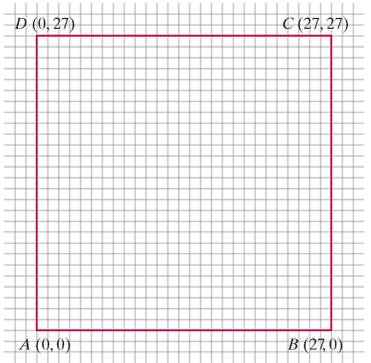
Concept explainers
Exercises 31 through 34 refer to a variation of the chaos game. In this game you start with a square ABCD with sides of length 27 as shown in Fig. 12-41 and a fair die that you will roll many times. When you roll a 1, choose vertex A; when you roll a 2, choose vertex B; when you roll a 3, choose vertex C; and when you roll a 4 choose vertex D. (When you roll a 5 or a 6, disregard the roll and roll again.) A sequence of rolls will generate a sequence of points
• Start. Roll the die. Mark the chosen vertex and call it
• Step 1. Roll the die again. From
• Steps 2, 3, etc. Each time you roll the die, mark the point two-thirds of the way between the previous point and the chosen vertex.

Figure 12-41
Using graph paper, find the points
a. the sequence of rolls 2, 2, 4, 4.
b. the sequence of rolls 2, 3, 4, 1.
c. the sequence of rolls 1, 3, 4, 1.
Want to see the full answer?
Check out a sample textbook solution
Chapter 12 Solutions
Excursions In Modern Mathematics, 9th Edition
- 4. Solve the system of equations and express your solution using vectors. 2x1 +5x2+x3 + 3x4 = 9 -x2+x3 + x4 = 1 -x1-6x2+3x3 + 2x4 = -1arrow_forward3. Simplify the matrix expression A(A-B) - (A+B)B-2(A - B)2 + (A + B) 2arrow_forward[2 pts] 1. Let A = [. 1 -1 0 -343 and B = 05 5 -7 304 Compute (7A - 3B) - 4(2A - B).arrow_forward
- 20 2. Let A = = [ -2 0 1 3 ] and B = 2 3 -1 2 For each of the following, calculate the product or indicate why it is undefined: (a) AB (b) BAarrow_forwardTrue or False and whyarrow_forward10 5 Obtain by multiplying matrices the composite coordinate transformation of two transformations, first x' = (x + y√√2+2)/2 y' = z' (x√√2-2√2)/2 z = (-x+y√√2-2)/2 followed by x" = (x'√√2+z'√√2)/2 y" = (-x'y'√√2+2')/2 z" = (x'y'√√2-2')/2.arrow_forward
- Not use ai pleasearrow_forward4 The plane 2x+3y+ 6z = 6 intersects the coordinate axes at P, Q, and R, forming a triangle. Draw a figure and identify the three points on it. Also find vectors PQ and PR. Write a vector formula for the area of the triangle PQR and find its value.arrow_forward3.1 Limits 1. If lim f(x)=-6 and lim f(x)=5, then lim f(x). Explain your choice. x+3° x+3* x+3 (a) Is 5 (c) Does not exist (b) is 6 (d) is infinitearrow_forward
- 1 pts Let F and G be vector fields such that ▼ × F(0, 0, 0) = (0.76, -9.78, 3.29), G(0, 0, 0) = (−3.99, 6.15, 2.94), and G is irrotational. Then sin(5V (F × G)) at (0, 0, 0) is Question 1 -0.246 0.072 -0.934 0.478 -0.914 -0.855 0.710 0.262 .arrow_forwardAnswer the number questions with the following answers +/- 2 sqrt(2) +/- i sqrt(6) (-3 +/-3 i sqrt(3))/4 +/-1 +/- sqrt(6) +/- 2/3 sqrt(3) 4 -3 +/- 3 i sqrt(3)arrow_forward2. Answer the following questions. (A) [50%] Given the vector field F(x, y, z) = (x²y, e", yz²), verify the differential identity Vx (VF) V(V •F) - V²F (B) [50%] Remark. You are confined to use the differential identities. Let u and v be scalar fields, and F be a vector field given by F = (Vu) x (Vv) (i) Show that F is solenoidal (or incompressible). (ii) Show that G = (uvv – vVu) is a vector potential for F.arrow_forward
 Linear Algebra: A Modern IntroductionAlgebraISBN:9781285463247Author:David PoolePublisher:Cengage Learning
Linear Algebra: A Modern IntroductionAlgebraISBN:9781285463247Author:David PoolePublisher:Cengage Learning
